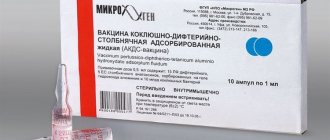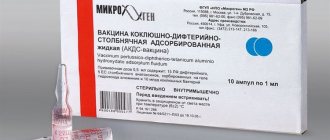Often mothers are against systemic immunization of infants, since after DTP vaccination the child develops negative reactions, for example, a lump that does not go away for a long time. It can cause swelling of the thigh and lead to a deterioration in the overall well-being of babies. Meanwhile, pediatricians do not advise skipping DTP vaccination dates, exposing children to the risk of contracting dangerous diseases.
In accordance with the vaccination calendar approved by the Ministry of Health, DTP vaccination is carried out in four stages, starting at three months of age, then at four and a half, six and eighteen. It is designed to produce antibodies to three infections - whooping cough, diphtheria, tetanus. The toxoids of the last two listed components are well tolerated, but the pertussis component is considered one of the most reactogenic, causing fever, local hyperemia, and swelling.
Bumps almost always appear in babies after DTP vaccination. If you follow all medical recommendations regarding actions during and after the injection, the compaction will not be large and will not cause serious conditions. Parents should understand in which cases they can carry out home therapy, which will help the baby endure the upcoming consequences of such an important health procedure, and in which cases emergency medical care will be required.
What is a lump and lump, why do they appear in a baby?
When a lump forms on a baby’s leg after DPT, mothers should not be scared or panic. The administered drug contains strains of tetanus, whooping cough and diphtheria, which have an enhanced effect on the child’s not yet established immune system. Redness appears at the site where the syringe needle is inserted in all children after DTP vaccination. This is exactly what a normal reaction of a baby’s body with a properly developing immune system should look like. In this way, the small organism remembers dangerous pathogens and learns to defend itself against them.
Is a lump at the DPT vaccination site dangerous? Causes of redness and thickening
Parents should not worry when their baby’s skin turns red from a DPT injection. This is how a healthy child’s body should react, including protective mechanisms. If the area where the vaccine was injected is hyperemic, this means that the immune system has begun to produce:
- antibodies;
- phagocytes;
- interferons.
A red DPT injection site is not considered a dangerous sign if the infiltration area does not exceed 8 centimeters in size. Such a reaction may be accompanied by a number of symptoms indicating the beginning of the formation of an immune response to the administered drugs:
- the appearance of lethargy and weakness;
- increase in temperature;
- reducing the baby's food intake;
- development of cough and runny nose.
If you follow the instructions for performing the injection, all these symptoms of malaise disappear after a few days.
Swelling of an area of the thigh or swelling of the entire leg
If the lump on the leg after the DPT vaccination does not go away for a long time, and the bump on the child’s leg begins to turn into edema, this may indicate the development of a secondary disease due to the vaccination. This happens when drugs were administered to an already ill infant, or instead of an intramuscular injection, a subcutaneous injection of strains was given.
The appearance of redness and itching at the site of DTP vaccination is also caused by an allergy caused by some component of the administered complex drug. Often in young children it is provoked by a component directed against whooping cough. It causes hives, the skin begins to itch and turns red. Typically, an allergic reaction in children does not occur immediately, but 1-2 days after the manipulation.
When scratching the epidermis in the injection area, a secondary infection may penetrate inside, the manifestations of which will be the formation of an abscess and swelling of the soft tissues.
Infiltration at the injection site
This is a pathological post-injection formation, which is observed not only in children, but also in adults, after various injections. Induration at the DTP injection site is the result of the development of a normal inflammatory process that is caused by the immunization. Blood and lymph accumulate at the injection site, resulting in a painful swelling of the soft tissue.
What compresses should I use to help a large infiltrate resolve?
To help the bump disappear faster, parents can use the following medications to relieve swelling:
- Aescusan (ointment) . Helps stimulate blood circulation at the injection site, allowing the seal to go away faster. Apply once a day. Better before bedtime;
- Troxevasin . Its composition of active components helps the lump to dissolve faster;
- Fenistil (gel) will come to the rescue if the baby is bothered by itching at the vaccination site. But the product should not be applied to the puncture site, but around it. Fenistil quickly relieves pain, and the baby calms down;
- Zodak and Tavegil . They will help get rid of seals if the baby is prone to allergies.
Don't rush to cure the lump yourself. Remember that you cannot smear the lump with Vishnevsky ointment (without a doctor’s prescription), much less put pressure on it, trying to remove the contents. The result may be the opposite - the compaction will fill with pus, causing an abscess.
Troxevasin ointment
For the same reason, you should not warm the lump yourself, even if it seems too big and painful to you. In this situation, you should consult your pediatrician.
An iodine mesh will help to quickly resolve the infiltrate. It is worn on the seal, and when it completely disappears, it is drawn again. A gauze compress soaked in a magnesium solution will also help. It is better to apply it to swelling before going to bed.
Among the natural remedies that can be used to reduce infiltration, it should be noted:
- soda compress . Proportion: 1 tbsp. soda to 1/2 cup warm water. Tie gauze (or cotton cloth) soaked in soda to the seal and wait until it dries completely;
- fresh cabbage leaf . It should be lightly beaten with a hammer so that the juice comes out. Apply to the swollen area until it dries (about 2-3 hours);
- raw potato compress . Finely grind the tubers. Form a flat cake and wrap it in cheesecloth. This bandage relieves swelling well.
The compress must “breathe”, so do not use film or plastic bags.
If the vaccination was completed correctly, the compaction will go away quickly. Parents should know that a lump may appear not only during the first DTP injection, but also after the 2nd and 3rd vaccination. This is fine.
You should only worry if after vaccination the baby exhibits the following symptoms:
- the compaction does not subside for a long time or even increases (more than 6-8 cm in diameter);
- high (over 38.5 degrees) temperature;
- pus can be felt in the compaction, protruding at the puncture site;
- nausea and poor appetite;
- the infiltrate is “hot” and painful.
Such symptoms are a sign of an abscess. And in this case, soft tissue diagnostics is needed.
Abscess as a complication after vaccination and methods of its treatment
In cases where a child’s lump does not go away for a long time and quite quickly transforms into swelling of the leg with the appearance of an abscess, an abscess probably begins. This complication is usually accompanied by a jump in body temperature to 39 degrees. In this case, you need to think not about what to anoint the injection site after vaccination, but urgently seek professional medical help. The appearance of an abscess indicates that the administration of the DPT vaccine was done incorrectly, and infection began. The baby requires urgent hospitalization.
Purulent inflammation begins when current sanitary and hygienic standards are violated during vaccination or when a low-quality vaccine is used. This complication can also be caused by the infant’s intolerance to one or another component of the complex vaccine.
What is not allowed to do
To reduce the number and severity of the consequences of vaccination, parents must strictly follow all recommendations of pediatricians. In order not to subject the baby’s immune system to increased stress after the injection, it is not recommended to take the child out for a walk on the first day. You should not go for walks for a few more days if the baby has a fever and other symptoms of illness.
Do not heat the injection site so that the seal dissolves. This can lead to the development of inflammation, which turns into a severe purulent form. It is also forbidden to make an alcohol compress in the area of the injection.
If you have a fever and an allergic reaction to vaccination, you should use antipyretics and antihistamines with caution.
What medications should not be given after vaccination?
If the vaccination causes a slight fever in the baby, then this is normal. Parents do not need to give antipyretic drugs. They will interfere with the development of an immune response to the introduced weakened strains.
It is better to give antipyretic tablets only if the mark on the thermometer has reached 39 degrees. In this case, Paracetamol and Ibuprofen are best. If it is not possible to achieve a therapeutic effect, call an ambulance.
If your baby is allergic to any component of the vaccine composition, then you should not give him Suprastin or Tavegil. These drugs prevent the production of mucus in the bronchi, which is already insufficient in babies during the development of their immune system. This will lead to an increased risk of infection of the upper respiratory tract during the vaccination process, when the small body fights the introduced weakened bacteria and toxoids of dangerous childhood diseases.
To relieve an allergic reaction after the administration of complex vaccination preparations, it is safer to use Zyrtec or Fenistil.
How to make a compress after DTP vaccination?
In addition to the drugs presented, there are other ways to eliminate painful symptoms after vaccination.
Many parents practice applying various compresses to the problem area. However, there is a strict rule that must be followed. You should not warm up the injection site, as this will have a bad effect on the baby’s condition and worsen his health. In addition, before using any compress, you need to find out if your child is allergic to the components.
Basically, compresses are done when the reaction to the vaccine has passed, the inflammation and temperature have gone away, and only a lump or lump remains. In order for the resulting compaction to resolve faster, compresses are used.
Soda
One teaspoon of soda is added to one glass of pre-boiled water. You need to know that this compress can only be done one day after the injection. This compress is fixed on the child’s leg and left until the cotton swab is completely dry. If necessary, this event is repeated up to three times a day.
Vodka
The solution for this compress is diluted in a ratio of one to two. That is, one tablespoon of vodka to two tablespoons of water.
It is best to make a compress for a limited time, for example forty minutes.
The bandage is then removed. It is important to understand that this solution has a slight warming effect.
Therefore, its use is possible only after the inflammation has gone away.
It would be justified to use a compress to resolve the lump.
From magnesia
As soon as parents notice that a lump is forming at the injection site, they can immediately make a compress with a magnesium solution. This solution is freely available in pharmacies. Apply the preparation to a cotton pad and apply it to the bump, fix it. This procedure can be done at night.
With dimexide
The compress with this solution is also diluted, but in a ratio of one to five. A cotton swab is soaked in the product, applied to the lump, and fixed. Can be done at night or during the day.
Dimexide
The inconvenience of these compresses is that the child may be distracted by the bandage itself, as it can get in the way and irritate the baby even more. It is recommended to do compresses at bedtime, if this does not contradict the instructions.
When to go to the doctor
Not every lump on a child’s leg after vaccination is a signal to see a doctor. You need to call an ambulance in cases where, after the vaccine is administered, the injection zone turns into a large lump with a diameter of more than 9 cm. Infants usually experience high body temperature (from 39 degrees), convulsions and severe anxiety.
Convulsive attacks are caused by a severe form of allergy caused by some component of the administered drug. Purulent inflammation is also a very dangerous symptom and requires immediate contact with a pediatrician. The signal to call a doctor is, first of all, a thermometer reading of 39 degrees or more. It is impossible to cope with this situation without qualified medical assistance.
Symptoms of malaise at a body temperature not exceeding 38 degrees disappear after a few days. With proper home therapy, complications of immunization are quickly stopped, and the baby successfully develops resistance of the immune system to dangerous diseases.











